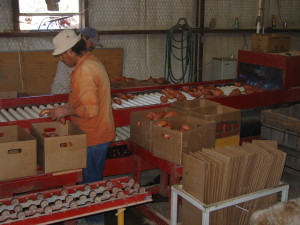
CANTON — Families can be snippy about their personal recipe for sweet potatoes, but the orange, fleshy vegetable usually shows up in some form at every Thanksgiving meal.
At a time of year when people tend to toss aside any notion of dieting, the sweet potato – depending on what’s added to it for the feast – is among the healthiest holiday dishes, being almost fat free, low calorie, high fiber and packed with vitamin A, according to the U.S. Department of Agriculture.
Sweet potatoes have more than the required daily dose of vitamin A, which form and maintain healthy skin, teeth, skeletal and soft tissue, mucousmembranes and eyes, according to the National Institute of Health. They are rich in a carotenoid called beta-carotene, which gives them the dark-colored pigments and protects human cells from damage caused by “free radicals” that cause certain chronic diseases and cancer, and speed up the aging process.
If a Texas-grown sweet potato finds its way to your table, all the better, though the sweet potato industry has been peeling back in recent years in the Lone Star State, according to U.S. Department of Agriculture figures.
Texas growers planted 1,000 acres of sweet potatoes in 2014, the USDA reports. While Texas is ninth among states with the most harvested acres, production has steadily declined from 16,000 acres in 1960 to 1,000 for the past 5 years.
North Carolina is far and away the top producer with 65,000 acres harvested this year. Mississippi and California run close at second and third place with 24,000 and 19,000 harvested acres, respectively.
Brian Cummins, who retired in 2010 after 19 years as the Texas A&M AgriLife Extension agent in Van Zandt County, said a combination of situations caused the decline of sweet potato production in Texas.
Aging farmers and lack of labor weighed in as causes, but chief among the impacts was the drought of 2011-12, since the Texas production was historically grown without irrigation in the eastern part of the state where rainfall had been plentiful.
“Plus, the price of sweet potatoes hasn’t increased,” Cummins said. “They’re still bringing what they did 20 years ago.”
Cummings said sweet potatoes are labor intensive from planting – where the slips are hand cut and transplanted – to harvest where up to eight people ride a machine to field grade potatoes that are dug two rows at a time.
“We could make 300-400 bushels per acre here on dryland farms, but in Mississippi with irrigation, they yield 600-800 bushels,” Cummins said.And perhaps the biggest challenge for the Texas sweet potato came from Mississippi as farmers there converted irrigated cotton and soybean fields to sweet potatoes, he noted.
Nevertheless, the 1,000 Texas acres churned up at least 15 million poundsof the orange-colored tubers this year, mostly headed for fresh, local markets.
Perhaps the highest concentration of sweet potatoes grown in Texasis in Van Zandt County, according to Dr. Joe Masabni, AgriLife Extension vegetable specialist in College Station.
“We had about 1,500 acres when I moved here in 1996,” said Tommy Phillips, AgriLife Extension agent for Van Zandt County. “Sadly, last year it was less than 400 acres.”
Phillips has a how-to publication ready for anyone interested in raising the crop. It starts with the transplant of seed potatoes, from five to 30 bushels per acre, depending on the variety, in early May or June. Three to four months later, depending on the variety and use of fertilization, irrigation and pest control, a Texas farmer can harvest about 15,000 pounds of sweet potatoes per acre, according to the USDA.
“Sweet potatoes sold soon after harvest are ‘green’ potatoes and are not sweet if baked,” Phillips explained. “Those held in storage for seven or eight weeks are sold as ‘cured’ or ‘kiln dried’ and that indicates they will be sweet and moist when baked.”
He said harvested sweet potatoes are moved quickly out of the field to prevent sun scald and are placed in a curing room at 85-90 degrees with 85-95 percent humidity for up to a week.
“Curing heals cuts and bruises on the roots, which makes them look better and be less susceptible to disease in storage,” Phillips added. “Once cured, they can be stored for several months at 55-60 degrees.”
If a commercial operation is not in the plans, Masabni offers a publication, Easy Gardening: Sweet Potato, to help people who want to grow their own sweet potatoes for next Thanksgiving. It can be downloaded for free athttp://www.agrilifebookstore.org/Texas-Sweet-Potato-p/eht-026.htm.
“Hot days and warm nights are ideal for sweet potato production,” Masabni said. “Sweet potatoes are extremely heat tolerant but can also tolerate light frosts as long as the soil temperature remains above 55 degrees.”
Masabni’s publication describes how to grow “slips” from healthy sweet potatoes and then transplant outside. It also details pest control, fertilization, watering needs and harvesting methods.
“For home growers, the best time to harvest is immediately before or after the first fall frost, when the leaves turn yellow,” he said.





